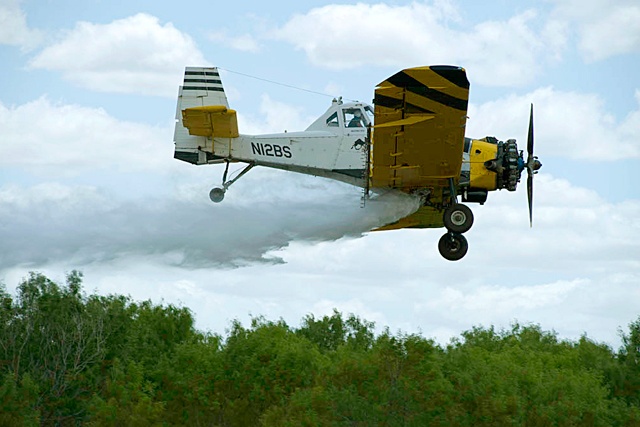Several years ago, George Mitchell received a complaint phone call from a woman saying a low-flying airplane from his Beaumont-based aerial spraying business was going to crash into her house.
Mitchell explained that: A) such a crash would kill the pilot, who certainly had no intention of dying that day; and B) the pilot was seeding rice, which required making low flying passes over a field.
The woman retorted that all the rice is sown in Indonesia. Dumbfounded, Mitchell told her that his planes seed rice fields in the Beaumont area and along the Gulf Coast—and had been doing so for years. “She didn’t know that was a rice field near her house,” says the 71-year-old Mitchell, the second-generation owner of M&M Air Service, the first aerial application business to ever seed a Texas rice field. “It appalled me.”
Ninety years after an airplane was first used for crop dusting, ag pilots salute the pioneers who made their careers possible. But at the same time, modern-day aerial applicators have left the past in the dust. The image of the crop duster, glorified, vilified and romanticized in literature and movies, is just that: a fading picture of an old-fashioned pilot whose very title, crop duster, is synonymous with barnstormer.
Execute a spin, roll or loop on the job these days, and you’ll immediately be fired. Safety and professionalism come first in an industry that prides itself on accountability and results. Aerial application accounts for about 25 percent of the nation’s 300 million-plus acres that are treated with crop-protection products each year, according to the National Agricultural Aviation Association.
Aerial applicators also protect public health by fighting fires and spraying disease-carrying mosquitoes. But ask ag aviators the biggest challenge facing their industry, and they’ll give the same answer: public perception. Every day, ag pilots battle misconceptions that they’re daredevils flying by the seat of their pants, recklessly spraying poison across the countryside.
Aerial applicators spray heavily diluted products, explains Leif Isaacson, owner of Desert Air Ag in Terreton, Idaho. Isaacson’s work includes organic crops, such as alfalfa, barley, potatoes and wheat. Potatoes, for example, are treated with fish oil-based fertilizers and copper-based, fungicide blight sprays, both of which are lightly applied. A typical fungicide application, for instance, consists of 7 ounces of product diluted with 7 gallons of water, sprayed over one acre (43,560 square feet).
Nonorganic crop products are applied with the same dilution levels, ag aviation officials say. Within their own ranks, ag pilots sometimes still call themselves crop dusters, but it’s merely a holdover term. Today’s aerial applicators spray mostly liquid products to enhance plant growth and control crop-threatening insects, weeds and diseases.
“We’re not scarves and goggles any more,” Mitchell says. He notes that with millions of dollars invested in state-of-the-art technology, such as GPS and precisely calibrated spray equipment, ag aviation “has really come a long way, baby. They’ll start calling our industry aerial bionics before it’s all over.”
It’s important to understand, Mitchell says, that aerial applicators are professionally trained pilots who don’t go looking for risks in a career field that’s inherently dangerous enough. “We had to dispel the image of a flying circus,” says Mitchell, who flew ag planes from 1956 to 1997. “We’re not the cowboys of the air.”
But ag pilots sometimes look for lost cowboys. In late August, Isaacson flew two days high in the rugged terrain of Idaho’s Bitterroot Mountains, helping search for a missing ranch hand who was moving cattle across a valley. The cowboy’s horse came home, but he never did.
Law enforcement officials sometimes call upon Isaacson and other ag pilots across the nation to be on the lookout for stolen vehicles. Often, they spot the vehicles, either driving down the road or hidden in some spot that only a low-flying pilot could see.
Isaacson—who as a young pilot in California built up flying time transporting bodies for his father, a mortician—has seen and heard some strange things throughout his career.
But it’s hard to top the call that Isaacson got one day from one of his pilots who said he had just accidentally sprayed a bicyclist riding in the middle of a potato field. The pilot was spraying blight fungicide, which posed little threat to the bicyclist. But the obvious questions were: Who was the bicyclist? And what was he doing in the field? Ah, there was one clue, the pilot said: The bicyclist wore a number on his back.
Sure enough, there was a race that day, so Isaacson tracked down and called the event’s officials, explaining that one of their competitors had been sprayed and, as a precaution, should be washed off. Could they help find him? Race officials weren’t able to identify the individual, and nobody ever came forward. As it turns out, the mystery bicyclist was probably cheating by cutting through the field.
The eyes of the potatoes—and the pilot—were upon him.
——————–
Camille Wheeler, associate editor

